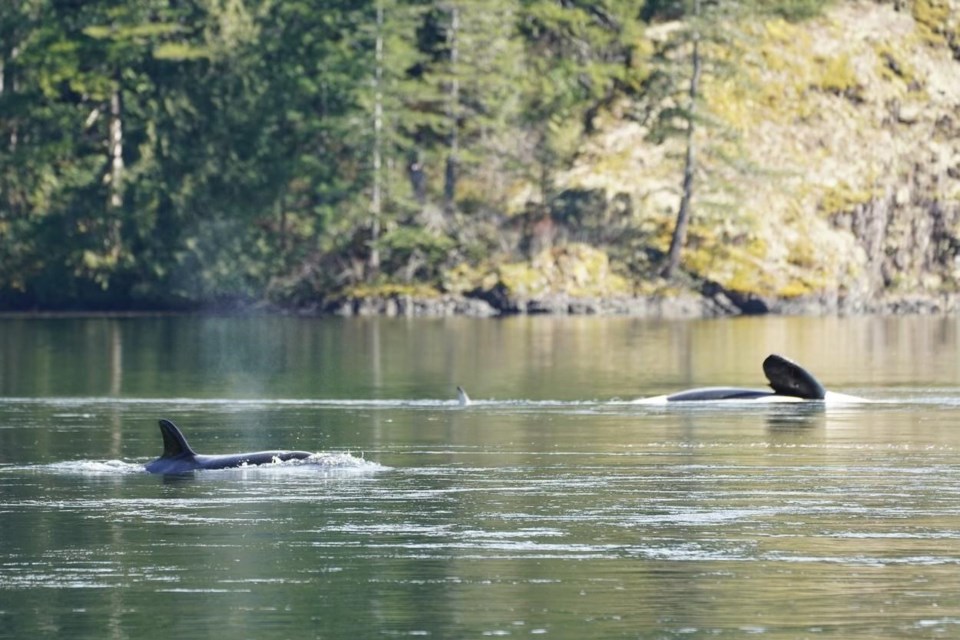ZEBALLOS, B.C. — A killer whale calf stranded in a lagoon without its mother to guide it to the open ocean off northern Â鶹´«Ã½Ó³»Island appears traumatized as a rescue team tries to coax it to move toward a possible reunion with its extended family, a marine scientist says.Â
Jared Towers said Tuesday the rescue team only has about 30 minutes daily when the tide rises to the point where the two-year-old orca calf can safely navigate itself out of the lagoon, near the village of Zeballos, located more than 450 kilometres northwest of Victoria.
The calf's mother, a 15-year-old Bigg's killer whale, died Saturday when she became beached at the lagoon and could not free herself despite rescue efforts of local First Nations residents and others.
Towers said they've tried to entice the young whale to leave the lagoon using acoustic orca calls and other methods, but the calf has stayed at the other side, retreating instead to the deepest part of the lagoon.Â
"We tried to move that little whale out over the shallows and back out into the inlet," Towers said Tuesday during an interview. "Unfortunately, the whale responded in a way that made us think it must be a bit traumatized. Unfortunately, it swam to the other end of the lagoon."
A statement Tuesday from the Department of Fisheries said efforts to convince the young orca out of the lagoon with playback of recorded calls from members of its pod were not successful.
The Fisheries statement said the department's marine mammal response unit and fisheries officers were at the lagoon area, but "the tide window is closing over the next few days which may not allow for on-water efforts during that time."
DFO and Towers, who is with research group Bay Cetology, said a necropsy conducted on the orca calf's mother found it was pregnant at the time of its death.Â
"Yesterday, unfortunately, we extracted a fetus from the mother," said Towers. "The little two-year-old that's entrapped right now had a little sibling on the way."
A statement from Chief Simon John of the Ehattesaht First Nation in the Zeballos area said they had named the young orca Kwiisahi?is, or Brave Little Hunter.
"It is really important to remember that we are connected to these animals and I believe these events are really difficult but really important," he said. "We have to take a bit of time to think what it means to us all. In our stories the killer whale came onto land and transformed into the wolf and then the wolf transformed into man."
The chief was not immediately available for comment Tuesday as he was out on the water with nation members looking for orca pods that may reunite with the stranded calf.
Numerous First Nation members along with other residents of Zeballos attempted to help the stranded orcas on the weekend.Â
"They are such magnificent animals and I have been with them on the water almost my whole life," said John. "Being so close and touching her, seeing her calf and being so helpless is hard to describe. It's really upsetting and we had so many from the local community there to help but when you have a sad ending it really is hard on everyone who was there."
The chief said the lagoon has always been a hunting ground for killer whales pursuing seals, but it appears the mother went too far up the beach at the time the tide was changing.
Towers said the lagoon is a difficult area to navigate and getting out depends largely on the timing of the high tide.
"What separates the deep water in the lagoon and the deep water of the inlet is a tidal narrows," he said. "There's only half an hour every day that the whale can pass through that area as the tide goes slack, because other than that there's a lot of current, some rapids and for the most part very, very shallow water."
Towers said a rescue of a young orca trapped in shallow water then reunited with its family is not without precedent in B.C.
In 2013, a three-year-old orca calf became trapped off the Central Coast but managed to get out to the ocean and found its family, Towers said.
"We didn't know what to expect and amazingly that little whale went out into the open water of Hecate Strait and ended up over time meeting up with some extended family members and today it's a healthy adult female," he said.
Towers said up to now the Zeballos orca calf appears healthy.
"It's got a great voice on it and it's using that voice, making a lot of loud calls," he said. "These killer whales can hear each other for many miles. It's just a matter of getting it out into the open water and letting it do the rest."
— By Dirk Meissner in Victoria
This report by The Canadian Press was first published March 26, 2024.
The Canadian Press



